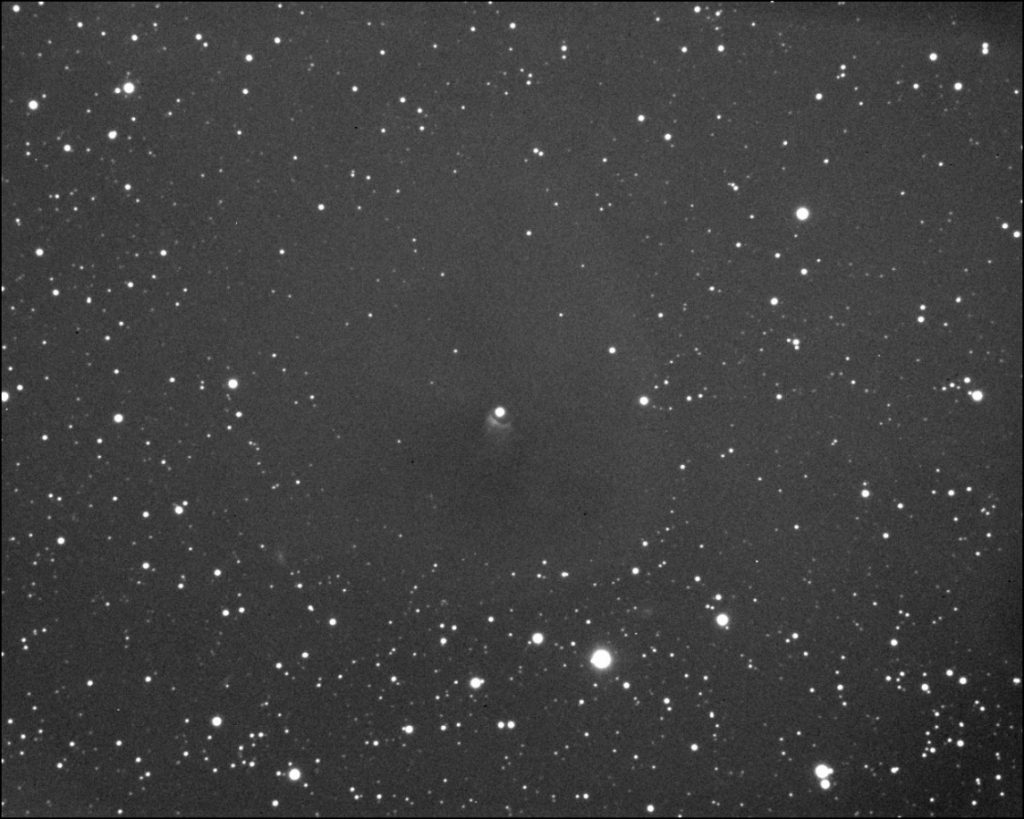Deep Sky Notes
Deep Sky Notes ate articles which have been submitted by members. This provides more prompt publication than might have been with the PDF Newsletter. Contributions form members is encouraged – please just contact the Director
Cosmic Horseshoe
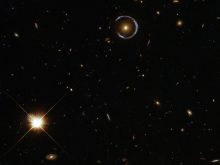
Deep Sky Note #4
When I read Callum’s Deep Sky Update for February, I totally missed the mention of the Cosmic Horseshoe so, it was only when observations started turning up in the BAA Gallery that I became aware of the suggestion to image it
[1]. I’ve imaged the double quasar in Ursa Major before and did try a gravitational arc (and failed) several years back, but I have not attempted any lenses in a long while.
Not that it would have mattered anyway, as the weather here in south west Wiltshire was as miserable as sin – and, whoever coined that expression, clearly lacked imagination. Here, we got lots of rain, the garden pond was overflowing and the few clear nights that did occur seemed always to synchronise with other activities.
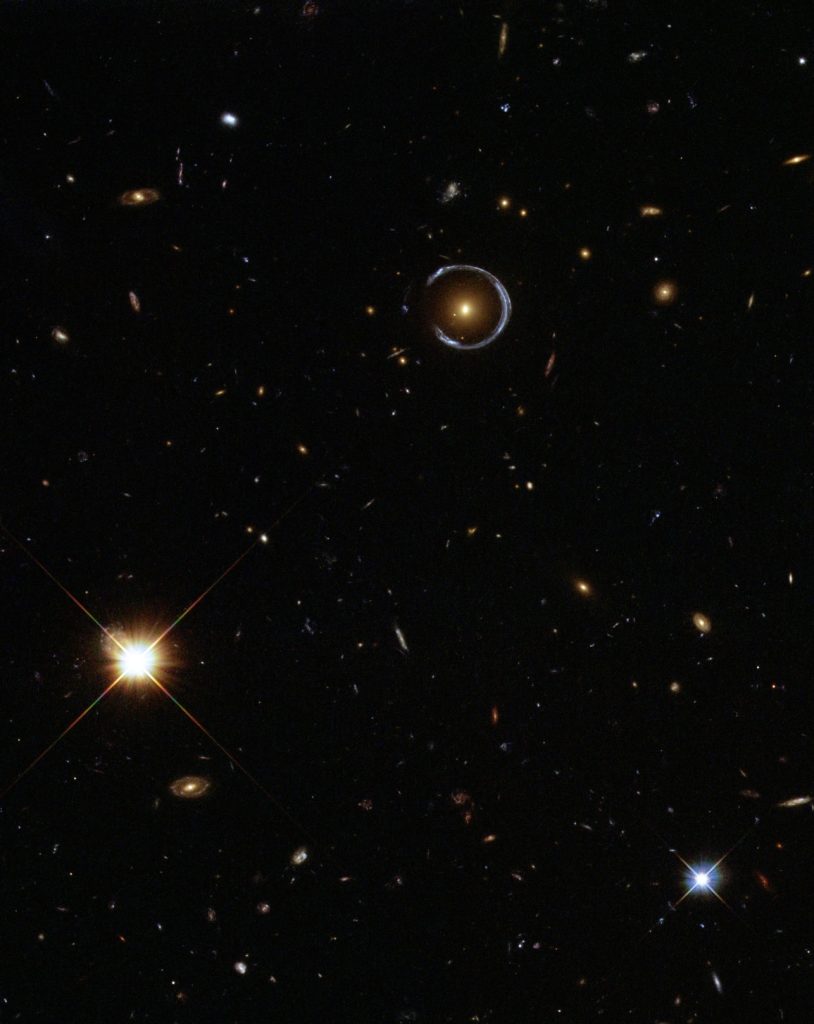
This meant there was no chance for me to participate in the observing attempts until the shorter nights of mid-April, when Salisbury got a couple of half decent clear moonless sessions on the 17th (dark, clear, good seeing) and the 19th (dark, slightly hazy initially, seeing average). Obviously, by mid April you have to stay up later for astronomical twilight to end, but that occurred at about 21:25 which is hardly late – the 19th was a particularly nice surprise as the Met Office, MeteoBlue and BBC websites had all forecast only a brief gap in the clouds.
Anyway, after spending some twilight time looking at McNeil’s (still absent) Nebula and C/29P’s latest outburst, I settled down to look first at JUICE, which I caught at 500,000 miles range – yeah, I know its pointless, but I find it fun – and then moved on to the Cosmic Horseshoe. I arrived at it just after it had crossed the meridian and captured ~250x 30s frames – giving up only because I had dozed off in a chair and the manual dome prevents letting it capture images unattended. On the second night I again went after JUICE (now at 1,100,000miles range – again successfully) and then on to the Cosmic Horseshoe which I imaged using ~120x 60s exposures, with roughly half collected either side of the meridian. I have to say a manual dome is probably good for me, as every 30minutes I need to go out and realign it and, if things were fully automated, I would get far less exercise on a clear night
[2].
The instrument used was a 300mm f/4 Orion Optics UK Newtonian which was mounted on a 2007 era SkyWatcher NEQ6 with a Rowan band update. The camera employed was a Starlight Xpress Trius 694 with a mono sensor being run a -30C and x2 binning. I had intended to use x1 binning but forgot what the binning default setting was on the SXcon software – despite having written it. At the start of each night I also checked the telescope collimation. Best guesses for sky brightness are 17th April mag 21.0 and 19th April mag 20.8.
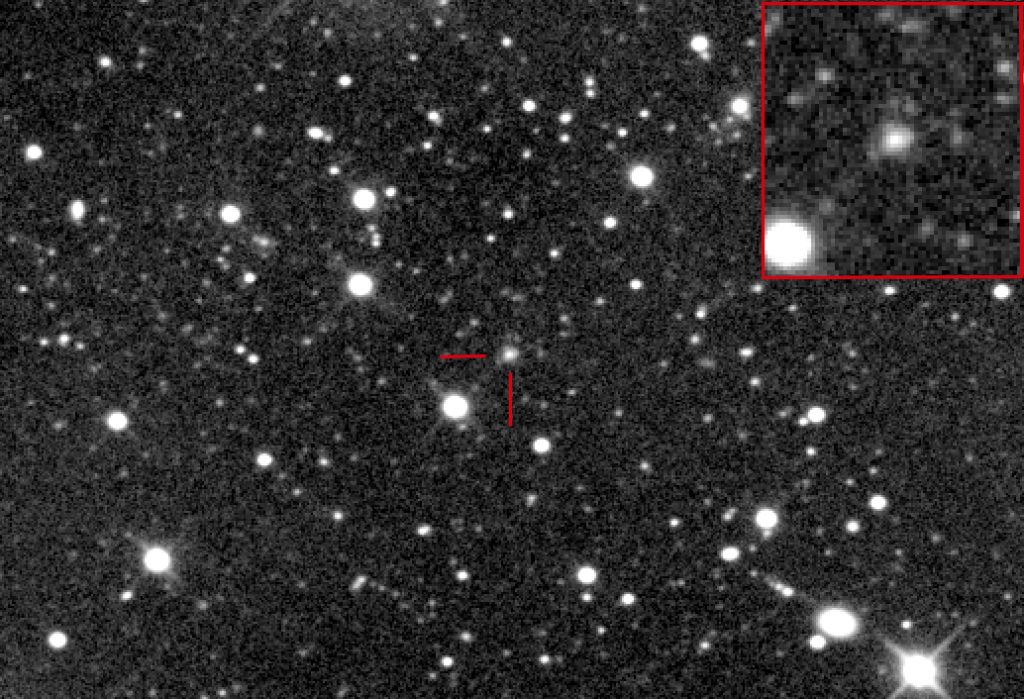
I have to say that even after 4 hours, its not an inspiring field of view. Nothing much in the way of bright field galaxies and only one asteroid noted plus…. the lensing galaxy.
LRG 3-757, doesn’t look much to write home about either – despite being 10x more massive than the Milky Way and being strikingly red in the Hubble image. But, realistically, what would you expect from a galaxy that is quoted as mag 20.8 at Gaia g and 18.2 in the i band – the 300mm Newt isn’t the Keck. Even so, it can be clearly seen in the image and, as someone who, in the 1980s, gawped in admiration at the emulsion based images of Ron Arbour and Jack Newton, I’m pretty content with how it came out.
Looking closely at the image it seems to me that the outer edge of the galaxy on one side is closer in to the centre of the galaxy than on the other sides. As the edge in question is where there is a gap the ring structure of the gravitational lens, I’m tentatively suggesting that I may have got it. Certainly, checking the magnitude scale Zero Point (ZP) of the image using Gaia g comparison stars suggests that magnitude 21 objects are present in the scene, so a detection is plausible. The only shame is that the platescale is 1.58 arc secs per pixel which means the lens is not resolved. However, if I had used x1 binning the image would have been a lot dimmer – I would have needed 4x the exposure to get an equivalent result and 16 hours on one object is a long time when you don’t own a remote automated observatory in Spain, Chile or Australia – what, me jealous? 🙂 . Its open to question whether I would have devoted 8 nights to the task. Certainly not this year.
I was also curious to see how the two image sets compared – the 2 hours worth of 30s exposures versus the 2 hours worth of 60 images. Now, as the images were not taken simultaneously using identical imaging systems, its hard to be truly definitive but, oddly, the 30s image stack looks the better of the two with marginally sharper stars. This might be due to slightly more blurring of the star images in the 60s images, arising from the unguided telescope or due to the slightly poorer seeing mentioned before.
Something else I looked at was the impact of one of the image stacking parameters AstroArt8 provides. It offers the option of using fractional pixel offsets ie presumably, employing interpolated values rather than using nearest neighbour values when stacking. Looking very closely at the results – pixel peeping, there is a difference between the images, but not as much as I had expected. The interpolated image looks very slightly lower contrast, but all significant features appear in both products. This did surprise me but the result may be down to the large number of images used and the plate scale – which is roughly half the normal seeing disc.
So, what have I learned?
1, a 300mm aperture, at a darkish site, can show the presence of the gravitational arc known as the Cosmic Horseshoe in just 4 hours of imagery. However, if you need the arc to be clearly resolved, then a considerably longer light collection period would be needed.
2, The exposure time needed for a detection using a 10” or 8” aperture would be significant. By contrast, 14” or larger, instruments used at a dark site will do very well.
3, I will probably always use nearest neighbour stacking when I have >50 frames.
4, I won’t worry about whether I use 30s or 60s exposures – the result is very similar.
5, Guided exposures will probably be needed to go much fainter than mag 21.
Anyway, I hope this was of some interest. Once again it looks like, when you image the deep sky, collecting an hours data should be seen as the bare minimum.
P.S. For anyone who wondering what you would get imaging it for >30hours with a 14” Planewave from a dark site in New Mexico….https://www.astrobin.com/enokjo/B/
[1] In my defence, I blame the distraction of Mike Harlow’s excellent sequence of observations of Gyulbudaghian’s nebula. It is very good. If you have not seen it, go and have a look at: https://britastro.org/wp-content/uploads/2023/03/MrG_3years_mjh1.jpg
[2] That said, if anyone knows how to easily automate an early Pulsar dome, then I’m all ears.
Albireo Unbound
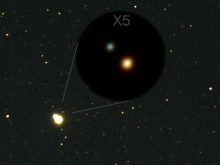
Deep Sky Note #3
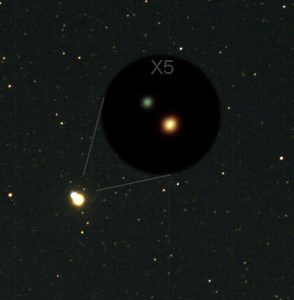
It has long been a matter of heated contention whether this gorgeous double star is a physical binary or merely a chance line-of-sight alignment, and you’ll find all sorts of conflicting statements made on the subject in recent books and on current websites. Neither of the modern astrometric satellite observatories HIPPARCOS or GAIA have yet managed to settle the matter definitively, although their parallax determinations for the two stars do suggest a difference in distance of anything up to 30 light years, well below which the two could not possibly be coupled together in a binary. The transverse separation projected on ‘the plane of the sky’ is 0.07 light years or 4440 times the Sun-Earth distance but that is obviously only a lower limit to what it could possibly be and the actual separation may be far larger: as yet, we just don’t know.
However, despite that, there is now sufficient data available to do a dynamical test (rather than a merely astrometric one) of whether the two stars can possibly be gravitationally bound to each other, a fact which does not seem to have been generally noticed (and only a couple of days ago I came across a webpage by a professor in my own university devoted to Albireo as a classic case of a visual binary, which latter at least it most certainly is not! But said professor is clearly not a practical, i.e. observational, astronomer). I’ve been reviewing the latest available relevant data this week, and doing some simple 2-body dynamics with it, with the following results:
The relative velocity (i.e. ‘internal’ velocity within the AB pair, discounting any shared common motion) of the two stars Albireo A and Albireo B is 6.7 km/sec to about +/- 0.1 km/sec, while assuming the extreme case most favourable to their being bound together by their mutual gravitation – that is, that they have zero separation along the line of sight (extremely improbable) and are therefore ‘only’ 4440 A.U. apart – and combining that with the best estimates of the stellar masses in a calculation which is essentially the 2-body fully generalized dynamical form of Kepler’s 3rd Law, the equivalent escape velocity of A and B from that least-possible separation is only 2.15 km/sec at most, again +/- about 0.1.
Conclusion: Albireo A & B cannot possibly be gravitationally bound to each other even if they are at exactly the same distance from us – so we don’t actually need to wait for GAIA to pin down the two distances finally, to settle the matter. This conclusion holds by a very large safety-margin and so is robust in the face of remaining uncertainties of data. It didn’t at all have to be so but, as it turns out, it is. To put that in the relevant dynamical terms, to ‘bind’ A & B gravitationally at that least-possible 4440 A.U. would require approximately 9.4 times their known total mass, making that of the combined A+B ‘system’ 109 solar masses – completely out of the question by a factor of at least 5.
Albireo is not a binary star – case closed!
Going Deep – In Pursuit of Z=5
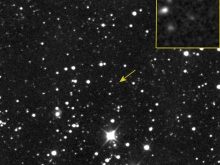
Deep Sky Note #2
After many years of regularly upping stumps and following my employers around the country, I am now approaching full retirement and if the company want to move again, they can flaming well do it without me. Consequently, I have finally been able to assemble a small observatory and am more often able to stay up late – very late.
Because we ended up in south Wiltshire, I had a choice of living amid the bright lights, buzz and metropolitan glamour of Salisbury or being further west in the Cranborne Chase AONB, where a sheep crossing the road warrants a 2 page article in the Parish newsletter. Given that Tescos deliver, Amazon works fine and I don’t exactly follow fast fashion (despite my well deserved reputation for sartorial elegance), we opted for living in an area which, on the Philips light pollution map is dark blue:indicating the sky can be mag 21 on a good night. It’s not La Palma, nor Haleakala, but its pretty good for the south of England.
So, given that I am now likely to stay put for a few years, I have been able to erect an old 2.1m Pulsar dome, which I found being sold second hand locally. Thats a real joy – I have lower back vertebra that personally thank me every single clear night – and my set up time has dropped from 70 minutes to 15 minutes. The dome is not driven but, as I’m now officially ancient, I probably need the exercise of nipping outside to rotate the dome a shove every 30minutes.
Okay, there have been problems with stuff like TP-link refusing to work because the cheap n’ cheerful Chinese switched mode power supplies (SMPS) that powered the mount, CCD, heater and MiniPC were throwing a (subtle) wobbly by chucking lots of noise down the mains line (SMPS have some really fun failure modes which included turning off the CCD cooler and stopping the sidereal tracking randomly due to a floating voltage), but a Wifi repeater means I can now run things from indoors – yay! I will replace all the switched modes with a single linear PSU at some point, but theres no hurry as replacing 2 SMPs sorted most the problem.
So, what have I been doing with this new found freedom? Well, I’ve been doing CCD imaging since 1994 and while I still like taking pictures of striking fields of view, I am under no illusions: there are people out there who do it better. Some achieve it by greater skills, some by better kit and some by sending said nice kit to exotic locations, which lets them let them collect hundreds of hours of data a month! The standard of imaging these days is astonishing. People throw away pictures which would have graced the front cover of Sky&Telescope a decade ago. Also, I never really got into colour or filtered imaging and stayed monochrome, becoming good at dealing with sky gradients instead. Its possible I’m just getting old, stuck in my ways or cranky but, realistically, that probably started decades ago, and I was only practicing then – whereas, now, I seem to be getting good at it, and one should always play to one’s strengths. Consequently, rather than trying to take my “best” picture ever of something attractive, I like to see what can be squeezed out of the kit I have and know what the limits are. The results need only please me, no one else. It doesn’t have to be pretty.
On Christmas Eve I took, somewhat belated, delivery (well we were still in pandemic with messed up supply chains) of a 300mm f/4 Newtonian from Orion Optics UK – which was a bit of a shock as its only my second new OTA purchase in 50 years. A Celestron C14 or Meade 12” SCT OTA would have been nice and less of a squeeze in the small dome, but they were way out of budget and the greater focal length would be better matched with a large format CCD – ideally something like a QHY600 [1] – rather than a Starlight Xpress mono 694.
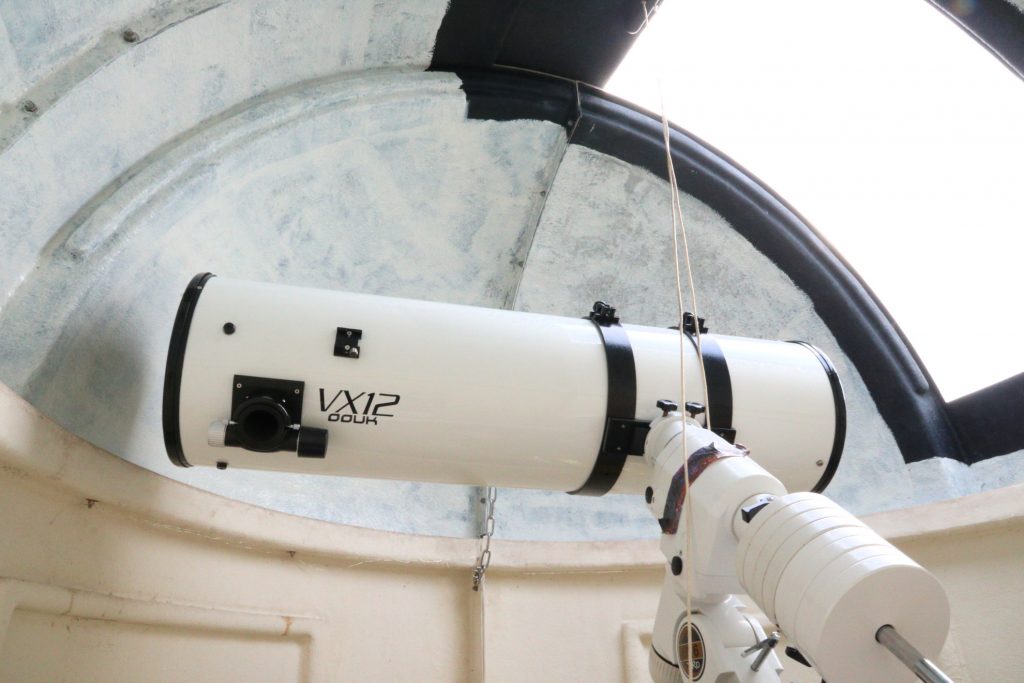
To read more you need to be a logged in member of the Association. Find out more about the BAA or join us.
[1] IMHO the QHY600 looks a thing of beauty and a joy forever from its specs and is high on my list of desirable items if Santa ever starts delivering to semi-retired, slightly arthitic kids. ↩
Observations of the Variable Star V347 Aurigae and its associated Reflection Nebula
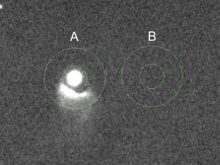
Deep Sky Note #1
This article presents some CCD imaging observations I have made of the variable nebula associated with the variable star V347 Aurigae. In particular, I describe some measurements I’ve made on images to investigate the relative timings of changes in the brightness of the star and of its reflection nebula.
V347 Aurigae is a pre-main sequence variable star that is still embedded within its natal molecular cloud and appears to have formed in relative isolation, far from known star forming regions. V347 Aur lies within a small molecular cloud known as Lynd’s dark nebula (LDN) 1438 where no background stars are apparent. The faintly luminous curved edge of a reflection nebula is evident to the south and southeast of the star, approximately 10.5 arc seconds from the star. As part of the Deep Sky section observing programme of variable nebula I have been routinely imaging the star and its associated reflection nebula since the beginning of 2021 and Figure 1 is one such example image taken on 2021 February 9. The equipment used was an Atik 460EX CCD camera fitted to a Celestron C14 telescope operating at f7. No filters used. Total exposure time is 27 minutes and the field of view is approximately 19 by 15 arcminutes. North is up and East to the left.
To read more you need to be a logged in member of the Association. Find out more about the BAA or join us.
| The British Astronomical Association supports amateur astronomers around the UK and the rest of the world. Find out more about the BAA or join us. |

